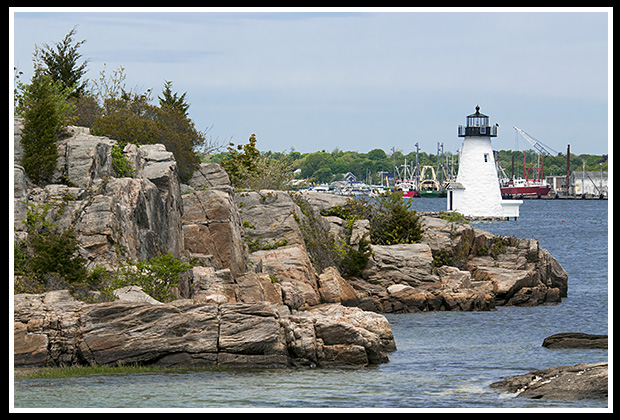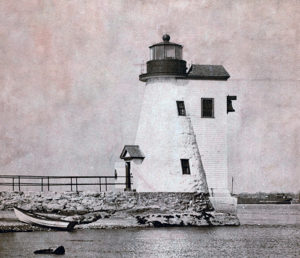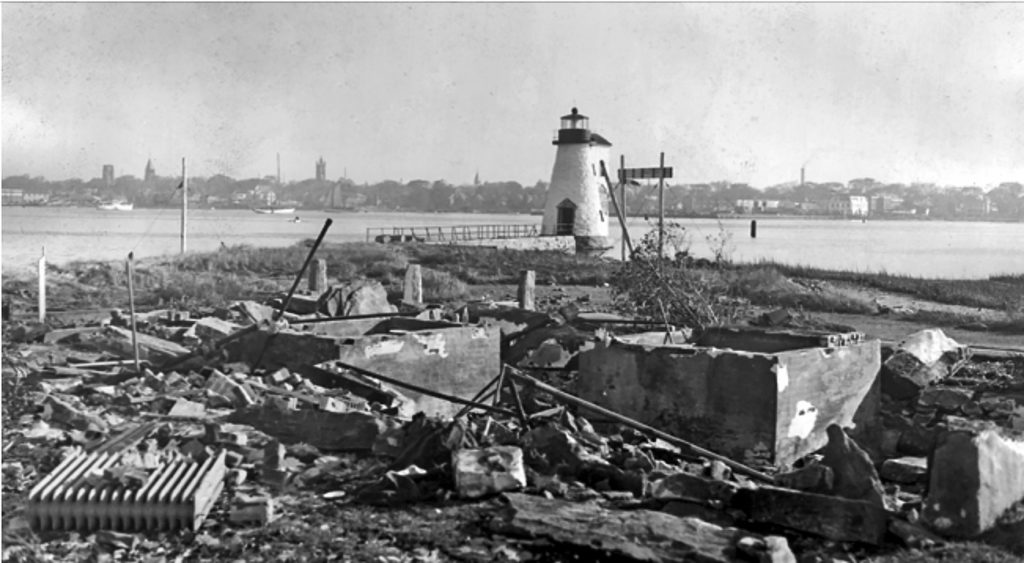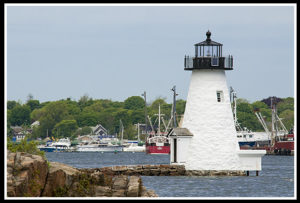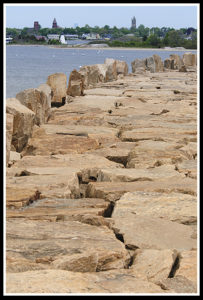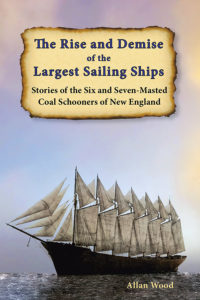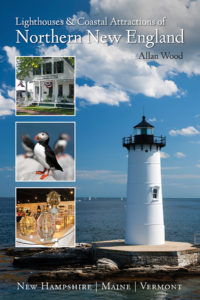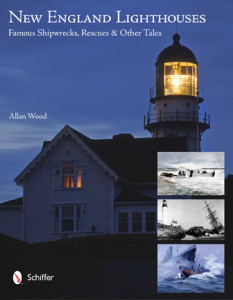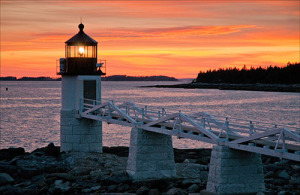Palmer Island Lighthouse in Massachusetts: Keeper Loses Wife During New England’s Worst Hurricane in 1938
Palmer Island is a six-acre rocky island marking the west side entrance to New Bedford Harbor in Massachusetts. Palmer Island Light was constructed in 1849 to guide traffic around the island safely. Arthur Small came to Palmer’s Island as a keeper in 1922, moving with his wife, Mabel, and two sons from Boston Harbor’s Narrows (“Bug”) Light. He was one of three lighthouse keeper brothers and was a gifted artist who often painted scenes on Palmer Island. He resided with his wife, Mabel, while tending Palmer Island Lighthouse.
New England’s worst hurricane occurred on the 21st of September in 1938, with little warning as high tides and fierce winds generated massive tidal surges sweeping into the harbor. On that miserable afternoon, as giant waves began to sweep over the island, Keeper Small had his wife take shelter in the oil house, which was located on the highest level of the island. He helped her secure a canvas bag around her neck and under her blouse, which contained their life savings of around $8,000.
As the winds increased, the keeper made his way to the lighthouse tower but was hit by a monstrous wave that swept him out the door from the island. Trying to swim between the dangerous floating wreckage, he was hit by a large piece of timber and was severely hurt. His wife Mabel saw her husband being swept out into the waters, and being an expert boatwoman, left the oil house and tried to unlash the boat to save her husband. As she was preparing her rescue, a giant wave smashed into the boathouse, carrying the structure and her away into the raging waters.
Keeper Small was able to make it back to the island, barely conscious, and believed his wife was safe in the oil house, which was still standing. Somehow, he managed to return to the island and believed his wife was safe in the oil house, which was still standing. He was so severely hurt from being smashed around in the wreckage of demolished boats and house material he could barely walk. He crawled up to the lighthouse tower, ensuring the light would keep burning during the storm, and started the foghorn as a sign of distress for help. He remained in the tower that night, collapsed, and waited for help. Mariners from the local boatyard in Fairhaven heard the foghorn and rescued him. The oil house was the only other building standing, but there was no trace of his wife. He was initially brought to St. Luke’s hospital, suffering from exhaustion and exposure.
Most of Arthur Small’s paintings and his extensive library of several hundred books were lost in the hurricane. He was eventually moved to recuperate at the Chelsea Naval Hospital near Boston. Three days after the storm, the Commissioner of the Bureau of Lighthouses called Arthur Small’s performance during the storm “one of the most outstanding cases of loyalty and devotion that has come to the attention of this office.”
Mabel’s body was later found in nearby Fairhaven; however, the canvas containing all their savings was missing. News regarding the loss of the canvas bag reached the area. When reporters asked what happened to the money he had secured unto his wife before she perished in the storm, the keeper would reply that someone must have cut the cord about her neck and taken the bag, as it would not have come loose in any other way. He stated it didn’t matter if he could have his wife Mabel back with him.
Arthur Small returned to duty as a lighthouse keeper at Hospital Point Light in Beverly, Massachusetts, where he finished his lighthouse career. He was also responsible for the lighthouses nearby at Derby Wharf and Fort Pickering. When the keeper died in 1958, the Coast Guard honored him with a burial at Arlington National Cemetery. There is also a plaque honoring both Arthur and Mabel Small, located on the Fairhaven side of the harbor at Fort Phoenix.
Decades after the Hurricane of 1938, and after enduring other monstrous storms, the largest hurricane wall on the East Coast was built in 1966 to protect the New Bedford residents.
Exploring Near Palmer Island Light
New Bedford is still a busy Massachusetts fishing port. Nearby, visitors will find the New Bedford Whaling National Historical Park with its cobblestone streets, specialty shops, and museums. For those who enjoy hiking, walk along the largest hurricane barrier on the East Coast, spanning over 9,000 feet, protecting New Bedford Harbor. To walk the entire wall span, start from Fort Taber Park, by Clark’s Point Light, and hike towards Palmer Island Light in New Bedford Harbor. Here are some photos of Palmer Island Light.
Enjoy,
Allan Wood
The Rise and Demise of the Largest Sailing Ships: Stories of the Six and Seven-Masted Coal Schooners of New England. In the early 1900s, New England shipbuilders constructed the world’s largest sailing ships amid social and political reforms. These giants were the ten original six-masted coal schooners and one colossal seven-masted vessel, built to carry massive quantities of coal and building supplies and measured longer than a football field! This book, balanced with plenty of color and vintage images, showcases the historical accounts that followed these mighty ships, from their initial launchings, battling destructive storms, and their final voyages.
Available in paperback, hardcover, and as an eBook for all devices.
Enjoy a 10% discount on the hardcover version. Printed and distributed by IngramSpark.

Book – Lighthouses and Coastal Attractions in Southern New England: Connecticut, Rhode Island, Massachusetts
My 300-page book, Lighthouses and Coastal Attractions of Southern New England: Connecticut, Rhode Island, and Massachusetts, provides memorable human interest stories from each of the 92 lighthouses, including the story about the Native Americans rescuing survivors of the City of Columbus mentioned above. You can explore plenty of indoor and outdoor coastal attractions, including whale-watching excursions, lighthouse tours, windjammer sailing tours and adventures, unique parks and museums, and even lighthouses where you can stay overnight. You’ll also find plenty of stories of hauntings around lighthouses.
My 300-page book, Lighthouses and Coastal Attractions of Northern New England: New Hampshire, Maine, and Vermont, provides memorable human interest stories from each of the 76 lighthouses, along with plenty of indoor and outdoor coastal attractions you can explore and tours. Lighthouses and their nearby attractions are divided into regions for weekly and weekend explorers. Attractions and tours include whale watching, lighthouse tours, unique parks and museums, and lighthouses you can stay overnight. There are also stories of haunted lighthouses in these regions.
There are over 50 other stories in my book New England Lighthouses: Famous Shipwrecks, Rescues & Other Tales. This image-rich book also contains vintage images provided by the Coast Guard and various organizations and paintings by six famous artists of the Coast Guard.
You’ll find this book and the lighthouse tourism books from the publisher Schiffer Books or in many fine bookstores like Barnes and Noble.
Copyright © Allan Wood Photography; do not reproduce without permission. All rights reserved.
Join, Learn, and Support The American Lighthouse Foundation
